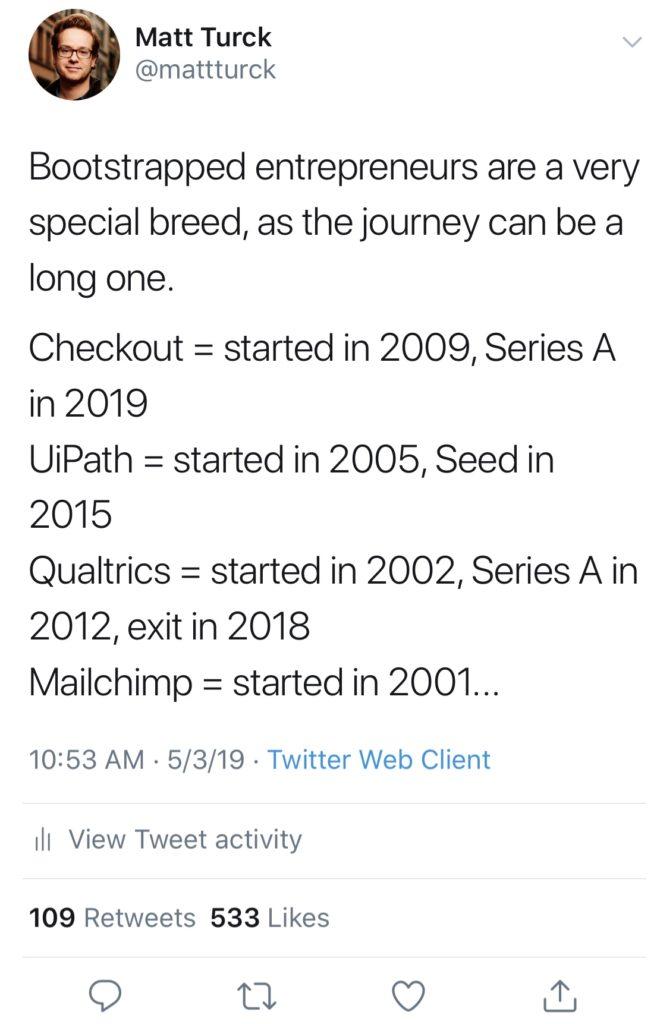
Perhaps this is slightly strange for an early stage venture VC, but I’m fascinated by entrepreneurs who bootstrap their tech startup and build them into very large, industry-leading companies.
The odds of building a massive company are low enough for the lucky few that manage to raise tens (or hundreds) of millions of venture capital money but, now, doing it with no outside investment? That is a really hard way to do it.
It can be a really long journey, as well. In fact, for all the obvious advantages of bootstrapping (less/no dilution, more control, etc.), the main trade-off involved in bootstrapping seems to be… time. It just takes longer to build a product and get to early scale simply based on cash-flow (or a small amount of debt or founder money).
I tweeted this a couple of days ago, and it led to an interesting thread:

For clarity, what I had in mind is really about a fairly narrow slice of bootstrapped companies: tech startups that on paper would be classic candidates for venture capital investment but, for one reason or another, do not raise outside money. There are many of other types of successful bootstrapped companies in tech, including commerce micro-brands, service providers and Wall Street tech ventures.
Also, bootstrapping can take many forms, including: (i) you never raise venture or private equity money (but you use credit cards, vendor credits, debt and/or raise from friends or family), (ii) you raise a small seed amount from VCs and then basically never raise again, or (iii) you don’t raise anything for a number of years (like 5-10) and then you raise a very large round (that sometimes people call a Series A, but in reality it has nothing to do with your usual Series A).
Within that narrow definition, there’s a number of other examples worth mentioning, both in enterprise and consumer businesses. In no particular order:
Enterprise / SMB / B2B:
- Atlassian = started in 2002, no VC raised, IPO in 2015
- Github = started in 2008, bootstrapped until $100M Series A in 2012, acquired by Microsoft in 2018
- Pluralsight = started in 2004, bootstrapped until Series A in 2013, IPO in 2018
- Dyn = started in 1998, bootstrapped until Series A in 2012, acquired by Oracle in 2016
- Automation Anywhere = started in 2003, bootstrapped until S250M Series A in 2018
- Blue Prism = started in 2001, almost entirely bootstrapped until 2016 IPO (apparently a $2.35M venture round in 2015)
- Squarespace
- Basecamp
- InsideSales
- Grammarly
- Qualys
- Zoho
- Appian
- SAS
- ESRI
- Yardi Systems
- Veeam
- Who else?
Marketplaces / Consumer / B2C:
- Wayfair
- CarGurus
- JustEat
- Scentsy
- Shutterstock
- Patagonia
- Spanx
- S’well
- who else?
There’s probably a strong survivorship bias at play (we only talk about the few companies that made it, as opposed to the many others that did not), but, when you think about the magnitude of success of those companies, this is a pretty remarkable list.
It’s interesting to note that many of those bootstrapped companies were started outside Silicon Valley, in an era that pre-dated the current wave of democratization and globalization of venture capital around the world.
For example, Qualtrics, Pluralsight and InsideSales were started in Utah and Mailchimp in Atlanta. Atlassian is an Australian company; UiPath was founded in Romania, etc.
So there’s a real possibility that many of those companies bootstrapped largely out of necessity, rather than choice.
But the world is a very different place now. Unprecedented amounts of venture capital money are now available to promising startups, regardless of stage and location. While it still helps, you certainly no longer need to be headquartered in the Bay Area to raise capital. Take Utah, for example: very few venture capitalists would invest in the region when Qualtrics and Pluralsight were being built. Fast forward to today, Utah is now hot, and a company like Divvy, for example, was able to raise $250M in venture capital (as well as $250M in debt) in just a couple of years. Ever larger venture funds are hunting for the next big thing all around the world, whether in Toronto, Paris or Mumbai.
So one interesting question in my mind is: as a result of this new context, do tech entrepreneurs bootstrap less than they used to? Or are there giant companies being built right now where founders have eschewed outside investment altogether, and we just don’t know about them just yet?
The pressure (or temptation) to raise venture capital early has probably increased over the last few years:
- There was hope at some point that, with cloud computing and open source software, you could start a company for cheaper than ever. But we have all learned that getting to scale quickly still requires a lot of money.
- The world has evolved towards subscription models (SaaS, subscription commerce, etc.), and those are much more cash consumptive that the perpetual licenses or one time sales from before.
- Competition for talent is fierce, and compensation expectations in tech have dramatically increased
- In a context where all your competitors raise large amounts of VC money, it can be incredibly difficult to be the one company that does not do so.
As a result, my guess is that, in the current environment, less and less founders choose to bootstrap for extended periods of time when they have the opportunity to raise venture capital. However, I don’t have data, and bootstrapped companies often fly under the radar for many years, so it’s hard to know for sure. I would love to hear what people think.
I can only think of a few current examples (worth bearing in mind that many VC rounds never get announced):
- Zapier reportedly only raised $1.3M in 2012
- Sketch just raised a $20M Series A, nine years after the company was founded
- Calendly officially never raised (but most likely did)
- Who else?
Regardless, bootstrapped entrepreneurs are a very special breed. Not that it is an easy thing with VC money, but it takes incredible amounts of courage, grit, discipline and patience to build a major company without outside financing (whether you never raise or raise after a long journey).
TransLoc is a good example of 10 year bootstrap before doing a Series A with SJF Ventures and Fontinalis before being purchased by Ford 18 months later.
Thank you
One thing to look at is do these founders who bootstrapped had prior successful exits which resulted them to pump in Millions of dollars of their own cash? in which case , they are acting as both investor/founder. Would be interesting to see how many bootstrapped with 5k ,10k or perhaps 25k or just with credit cards. Also would investment from family and friends count towards bootstrapping?
Good question. I think that in the list of companies I mentioned in the post, most were first time founders who did not have prior exits, but I’m not 100% sure.
And yes, I would think friends & family money would count towards bootstrapping… basically any kind of financing outside of venture capital and private equity, etc.
I think there are very good bootstrapped startups that are worth taking a look at and monitor. It’s harder to find these companies because they don’t go out of their way to look for investors. These opportunities require investors to proactively research and seek these gems and not wait to be approached. Investors who take the role of hunter rather than fisherman stand to gain more by coming in early to startup funded by its founders.
I tend to pay a closer attentions to bootstrapped founders because of the level of commitment they have to their companies. They are less likely to quit since their own money is on the line. Also, founders that bootstrap their companies invest the majority of their time developing the business rather than constantly working on the next round of funding. That effort can often take 50% of the founders’ time, if not more.
Magento (https://magento.com/) is a great example of bootstrapped company that grew very rapidly . It was bought by eBay from the founders about 6 years ago and is now owned by Adobe. Companies like Casamba (https://casamba.net/) in the healthcare sphere or CityPals (https://citypals.com/) in the travel industry are also interesting bootstrapped companies to look at.
All of those are great examples, thank you.
Here is my list that I have been tracking.
# bose
# esri
# bloomberg
# sas institute
# yardi
# epic
# valve corporation
# craigslist
# dyson
# soti
# mailchimp
Good list, thank you. Bloomberg is an interesting example — ‘sort of’ bootstrapped (seed capital was effectively provided by a big $10M termination fee when Mike was fired from Solomon Brothers), but they did raise a $30M strategic round from Merrill Lynch a couple of years into the life of the company.
Thanks for your interesting analysis. I think there are many good reasons not to take VC money . For example, the VC timeline is very pressured, they want to plough in money to ideas and see them succeed or fail fast – which is not always in the entrepreneurs best interest.
There is so much hype around VC-backed businesses but you highlight that there is another way for smart founders!
Agreed – venture capital certainly only makes sense for a very small number of startups.